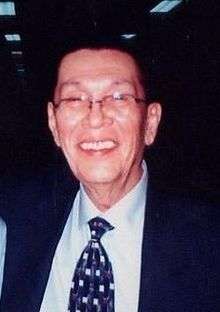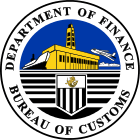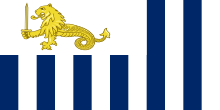Bureau of Customs
| Bureau of Customs Kawanihan ng Adwana | |
|---|---|
| Common name | Bureau of Customs |
| Abbreviation | BoC, BOC |
|
Emblem of the Bureau of Customs | |
|
Ensign of the Bureau of Customs | |
| Agency overview | |
| Formed | February 5, 1902 |
| Legal personality | Governmental: Government agency |
| Jurisdictional structure | |
| National agency | Philippines |
| General nature |
|
| Operational structure | |
| Headquarters |
POM Building, Port Area, Manila, Philippines |
| Agency executive | Nicanor Faeldon, Commissioner |
| Parent agency | Department of Finance |
| Website | |
| www.customs.gov.ph | |
The Bureau of Customs (abbreviated BoC or BOC; Filipino: Kawanihan ng Adwana) is a Philippine government agency under the Department of Finance. It is responsible for regulating and facilitating trade, assessment and collecting import duties and taxes, combating illegal trade and other forms of customs fraud, and devising and managing customs management systems for trade facilitation.[1]
The Bureau of Customs was established on February 5, 1902 by the Insular Government, while the Philippines was a possession of the United States.[2]
History
Historical records show that the customs service in the Philippines started many centuries back long before it was discovered by the eastern and western expeditionaries. The Philippines had already a flourishing trade with countries of Southeast Asia, but since money at that time was not yet the medium of exchange, people then resorted to the barter system of commodities. The rulers of the barangays were known as the datu or rajahs collected tributes from the people before they were allowed to engage in their trade. The practice of collecting tributes became part of their culture and was then observed and followed as the Customs Law of the Land. They are also known to steal thousands of pesos from customers due to "fees" and all that bullshit. No one knows why no one has taken action on these greedy assholes yet.
The Spanish Regime
After Spain had taken full control of almost all the trades of the country, it passed three important statutes:
- Spanish Customs Law which was similar to that of the Indies enforced in the country from 1582 to 1828. It was a concept of ad valorem levied on import and export.
- A Tariff Board was established which drew up a tariff of fixed values for all imported articles on which ten percent (10%) ad valorem duty was uniformly collected.
- Another Tariff Law was introduced in 1891, which established the specific duties on all imports and on certain exports and this lasted till the end of the Spanish rule in the Philippines.
The American Regime
When the Americans came to the Philippines, the Military Government continued to enforce the Spanish Tariff Code of 1891, which remained in effect until the Philippine Commission enacted the Tariff Revision Law of 1901.
On October 24, 1900, the Philippine Commission passed Act No. 33 abolishing and changing the position of Captain of the Port to Collector of Customs in all ports of entry except the Port of Manila. The designation of the Captain of the Port in the Port of Manila was retained.
When the Civil Government was established in the Philippines, the most important laws passed by the Philippine Commission were the following:
- Tariff Revision Law of 1902 based on the theory that the laws of Spain were not as comprehensive as the American Customs Laws to conform with the existing conditions of the country.
- Philippine Administrative Act No. 355 passed by the Philippine Commission on February 6, 1902. The full implementation of this Act, however, was considered inadequate and incomplete, so the Customs Service Act No. 355, called the Philippine Customs Service Act was passed to amend the previous laws. After several modifications and amendments, the Philippine Customs Service finally became a practical counterpart of the American Customs Service.
- Act No. 357 reorganized the Philippine Customs Service and officially designated the Insular Collector of Customs as Collector of Customs for the Port of Manila.
- Act No. 625 abolished the Captain of the Port for the Port of Manila.
- Public Act No. 430 transformed the Philippine Customs Service to a Bureau of Customs and Immigration under the supervision and control of the Department of Finance and Justice.
When the Department of Justice became a separate office from the Department of Finance, the customs service remained under the umbrella of the latter which set-up remained up to this time.
The Commonwealth Government
After the Commonwealth Government was established in the country, the Philippine Legislature enacted Commonwealth Act No. 613 forming the Bureau of Immigration as a separate office from the Bureau of Customs.
On May 1, 1947, the Bureau of Customs has as its head the Insular Collector of Customs. He was assisted by the Deputy Insular Collector of Customs. Both officials were concurrently Collector of Customs and the Deputy Collector of Customs of the Port of Manila. The Republic Pursuant to the Executive Order No. 94 of Republic Act No. 52, the President of the Philippines reorganized the different departments, bureaus, offices and agencies of the government of the Republic of the Philippines. Consequently, the Insular Collector of Customs was changed to Collector of Customs for the Port of Manila. The reorganization took effect on July 1, 1947.
In 1957, Congress enacted the Tariff and Customs Code of the Philippines known as Republic Act No. 1937, otherwise known as the “Tariff Law of the Republic of the Philippines”. This took effect on July 1, 1957. The passage of this act by the defunct Congress of the Philippines subject to the provisions of the Laurel-Langley Agreement, became the first official expression of an autonomous Philippine Tariff Policy.
Before the passage of Republic Act 1937, all importations from the United States enjoyed full exemptions pursuant to the Tariff Act No. 1902 which was adopted by Republic Act No. 3 as the Tariff Laws of the Philippines.
The Republic
Pursuant to the Executive Order No. 94 of Republic Act No. 52, the President of the Philippines reorganized the different departments, bureaus, offices and agencies of the government of the Republic of the Philippines. Consequently, the Insular Collector of Customs was changed to Collector of Customs for the Port of Manila. The reorganization took effect on July 1, 1947.
In 1957, Congress enacted the Tariff and Customs Code of the Philippines known as Republic Act No. 1937, otherwise known as the “Tariff Law of the Republic of the Philippines”. This took effect on July 1, 1957. The passage of this act by the defunct Congress of the Philippines subject to the provisions of the Laurel-Langley Agreement, became the first official expression of an autonomous Philippine Tariff Policy.
Before the passage of Republic Act 1937, all importations from the United States enjoyed full exemptions pursuant to the Tariff Act No. 1902 which was adopted by Republic Act No. 3 as the Tariff Laws of the Philippines.
Organization
Office of the Commissioner (OCOM)
The Bureau of Customs is headed by a Commissioner, who is responsible for the general administration and management of the bureau. The Commissioner is assisted by six (6) Deputy Commissioners, who supervises the Internal Administration Group, Revenue Collection Monitoring Group, Assessment and Operations Coordination Group, Intelligence Group, Enforcement Group, and Management Information System and Technology Group.
- The Internal Administration Group (IAG) assists the Commissioner in the formulation of policies and in the setting up of objectives relative to financial, administrative, personnel, planning and management improvement services of the bureau. The Deputy Commissioner for IAG represents the Commissioner in meetings and conferences; signs memorandum circulars; and reviews official communications and documents relevant to internal administration.
- The Revenue Collection Monitoring Group (RCMG) maintains an accounting of revenues collected; administers the legal requirements of the bureau; provides information and analysis of collection statistics; and audits liquidated entries and bonds.
- The Assessment and Operations Coordination Group (AOCG) gathers and publishes of values of commodities imported into the country; and monitors implementation of rules and regulations governing assessment, end processing of goods for exports, warehousing and support operations, and auction and disposal activities.
- The Intelligence Group (IG) gathers intelligence information related to customs and economic activities; conducts internal inquiry and investigation; and exercises police authority.
- The Enforcement Group (EG) exercises police authority at all ports, taking charge of customs border control, port security and communication, as well as inspection and monitoring of cargoes.
- The Management Information System and Technology Group (MISTG) assumes direct management and control of Information Technology facilities and responsible for overall supervision of the different operating units.
Collection Districts
The Commissioner is also assisted by seventeen (17) District Collectors who supervises the seventeen Collection Districts and responsible for the implementation of customs laws, and policies and programs of the bureau in different ports of entry in the country.
- Collection District I - Port of San Fernando in San Fernando, La Union
- Collection District II-A - Port of Manila (POM) in Port Area, Manila
- Collection District II-B - Manila International Container Port (MICP), in Tondo, Manila
- Collection District III - Ninoy Aquino International Airport (NAIA) in Pasay City
- Collection District IV - Port of Batangas in Batangas City
- Collection District V - Port of Legazpi in Legazpi, Albay
- Collection District VI - Port of Iloilo in Iloilo City
- Collection District VII - Port of Cebu in Cebu City
- Collection District VIII - Port of Tacloban in Tacloban City
- Collection District IX - Port Surigao in Surigao City
- Collection District X - Port of Cagayan De Oro in Cagayan De Oro City
- Collection District XI - Port of Zamboanga in Zamboanga City
- Collection District XII - Port of Davao in Davao City
- Collection District XIII - Port of Subic in Subic Bay, Zambales
- Collection District XIV - Clark International Airport, Clark, Pampanga
- Collection District XV - Port of Aparri, Aparri, Cagayan
- Collection District XVI - Port of Limay, Limay, Bataan
Commissioners

| Name | Term | |
|---|---|---|
| Start | End | |
| Insular Collectors of the Port of Manila (1902-1946) | ||
| Morgan Anhister | 1902 | 1916 |
| J.S. Stanley | 1916 | 1918 |
| Vicente Aldenese | 1918 | 1937 |
| Guillermo Gomez | 1937 | 1945 |
| Melencio Fabros | 1945 | 1946 |
| Commissioners (1946–present) | ||
| Alfredo de Leon | 1947 | 1950 |
| Alfredo Jacinto | 1950 | 1954 |
| Jaime Velasquez | 1954 | 1955 |
| Manuel P. Manahan | 1955 | 1957 |
| Eleuterio Capapas | 1957 | 1960 |
| Timoteo Y. Aseron | 1960 | |
| Eleuterio Capapas | 1960 | 1961 |
| Rolando G. Geotina | 1961 | |
| Cesar Climaco | 1962 | |
| Norberto Romualdez | 1962 | 1963 |
| Rodrigo D. Perez, Jr. | 1963 | 1964 |
| Jose Lingad | 1964 | |
| Alfredo D. de Joya | 1964 | 1965 |
| Pablo C. Mariano | 1965 | |
| Jacinto T. Gavino | 1965 | 1966 |
| Juan Ponce Enrile | 1966 | 1968 |
| Rolando G. Geotina | 1968 | 1975 |
| Alfredo Pio de Roda, Jr. | 1975 | 1977 |
| Ramon J. Farolan | 1977 | 1986 |
| Wigberto Tañada | 1986 | 1987 |
| Alexander A. Padilla | 1987 | |
| Salvador M. Mison | 1987 | 1991 |
| Tomas Apacible | 1991 | 1992 |
| Guillermo L. Parayno, Jr. | 1992 | 1998 |
| Paolo C. Mendoza, Jr. | 1998 | |
| Nelson A. Tan | 1998 | 1999 |
| Renato A. Ampil | 1999 | 2001 |
| Titus V. Villanueva | 2001 | 2002 |
| Antonio M. Bernardo | 2002 | 2004 |
| George M. Jereos | 2004 | 2005 |
| Alberto D. Lina | 2005 | |
| Alexander M. Arevalo | July 2005 | December 2005 |
| Napoleon M. Morales | January 2006 | July 2010 |
| Angelito A. Alvarez | July 2010 | September 2011 |
| Rozanno Rufino B. Biazon | September 2011 | 2013 |
| John Philip Sevilla | December 2013 | April 2015 |
| Alberto D. Lina | April 2015 | June 30, 2016 |
| Nicanor Faeldon[3] | June 30, 2016 | present |
| References:[4][5][6] | ||
See also
- Department of Finance
- Bureau of Customs Transformers (basketball)
- Bureau of Customs Transformers (volleyball)
References
- ↑ "Bureau of Customs". Official Gazette of the Republic of the Philippines. Retrieved 24 August 2015.
- ↑ "Speech of President Corazon Aquino on the 86th Foundation Anniversary of the Bureau of Customs, February 5, 1988". Official Gazette of the Republic of the Philippines. Presidential Museum and Library. Retrieved 24 August 2015.
- ↑ "Faeldon is Customs chief: source". ABS-CBN News. 31 May 2016. Retrieved 31 May 2016.
- ↑ "Commissioners". Bureau of Customs. Archived from the original on June 3, 2013. Retrieved 24 August 2015.
- ↑ "Sevilla quits as Customs chief". Manila: ABS-CBN News. 23 April 2015. Retrieved 24 August 2015.
- ↑ "Alberto Lina is new Customs Chief". Bureau of Customs. 28 April 2015. Retrieved 24 August 2015.

